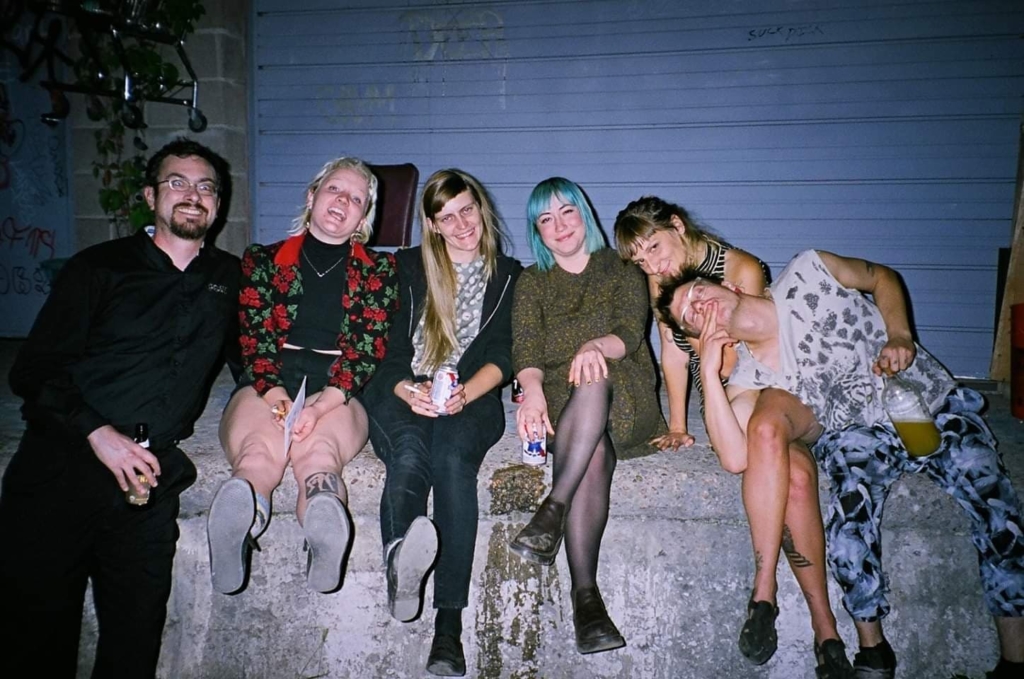By Josiah Hesse

For anyone that remembers pre-gentrification, pre-legal weed Denver, the all-ages, DIY venue Rhinoceropolis was the beating heart of our city’s underground art scene. Denver staples like the feminist/queer music festival, Titwrench, Denver Noise Fest, and the immersive art festival Fantasia, were born and thrived at Rhino. A young (pre-Elon Musk) Grimes performed there, and electronic musician Pictureplane (Travis Egedy) spent years performing and organizing shows at Rhino before moving to Brooklyn. And there’s Flosstradamus, Wolves In The Throne Room, and Lightning Bolt…we could go on.
Back then Rhinoceropolis was in a dark corner of a warehouse district, where artists endured poverty but enjoyed freedom. And then a dark cloud by the name of RiNo (River North) Arts moved in, appropriating the name of the DIY venue while transforming the neighborhood into a cartoonish playground for developers and corporate-funded art.
This was followed by the tragic fire at the Oakland DIY venue, Ghost Ship, where 36 people were killed and a panic about underground venues permeated the nation. Despite years of routine inspections from the Denver Fire Department, Rhinoceropolis was shut down by city officials shortly after the Ghost Ship fire, leaving several of its members homeless (including weirdo genius Colin Ward, who committed suicide shortly after) and a massive hole in the Denver arts scene.
Fast forward two years and Rhinoceropolis is back open, having complied with all the bureaucratic demands thrust upon them by various civic agencies. Rhino director John Gross has put in countless hours and energy making sure the venue has all the walls, ramps, electrics, bank accounts, permits and contracts needed to make it a legit, above-ground venue.
But can the spirit of DIY arts be maintained in a space that works hand in hand with city officials? We traveled out to the newly renovated Rhinoceropolis to speak with John Gross about this cultural conundrum, and what the future holds for one of our city’s finest arts institutions.
Honestly, after hearing about all the changes you had to make to get this place up to code, I was expecting Rhinoceropolis to look like a slick, AEG venue. But it still feels like the same place. What’s different about running this place today compared to before the shut-down?
Before, when we were living here and putting on events, it was like throwing a house party in my living room, so I didn’t care whether or not I turned a profit. It was about having a good time, and making sure the bands had enough gas money to get to the next place. For anything like this to work, the focus has to be on taking care of the artists.
Today I’ve got these laws and bureaucracy to conform to that we never bothered to deal with before.
What did you do before that you can’t now?
The biggest one is we can’t live here anymore. But I’ve also gotta operate as an LLC, and if we pay any bands more than $600 I gotta have them fill out a 1099. Which would never have crossed my mind before. It was all cash. But now we’ve got a square reader, a business bank account, online ticket sales, all the stuff that you would do when you think of a legit arts organization.

After the Ghost Ship fire and Rhino being raided, was there a period of time when you thought: “Fuck it, Rhino is over”? How big of a blow was all that to your spirit?
The Ghost Ship fire was still on my mind when the cops showed up that freezing cold night in December 2016. It was less than a week since the fire. Two of my personal friends died in that fire, who I’d met through this place.
The moment I saw it on the news, I called my friend and said “we’re gonna need to be careful.” But there was never any point in my mind that this was a “death trap,” which was a common phrase in the news about Ghost Ship. With the DIY scene there’s always an attitude of self-policing, so I told my team that we’re gonna have to up our game. In the back of my mind I thought: The city is going to be paying attention to us.
And then, soon enough, the Sheriff was here, social services, fire department, the press, all these city agencies watching us while we moved our stuff out. That was when I got a call from Vince from Meow Wolf and he asked, “What do you need?” And that’s when I thought we might have access to resources to keep this thing alive.

Did you have a sense of what it would take to keep it alive?
Absolutely not. I don’t know how anyone could without a background in commercial real estate and international building code. And yeah, there were times when I had doubts that we could pull this off. But I started hearing from a lot of people, who reached out to say how much they thought Rhinoceropolis meant to their community. I heard from a lot of people who said all-ages spaces are incredibly important for music culture. There are a lot of people who had their first exposure to the DIY culture here, the first time they could relate to people performing, and first time they experienced art that challenged them. And that gives them the idea that “hey, if they can do that maybe I can.” Then a few months later they called me and said, “I’ve got a band, can I book a show?”
Was Colin Ward’s death a factor in wanting to push on with Rhinoceropolis?
Colin was my partner in all this. He was going to have a big leadership role in the new version of the venue, and his suicide hit me really hard. I think it hit everyone really hard. I can’t know what was in his mind, but all of the hurdles, delays, red-tape and city bureaucracy stuff [at Rhinoceropolis] had a big impact on his mental state, and maybe made him do what he did. For him to suddenly not be there, I thought, “I can’t do it without him.” But at the same time, I had to keep going because that’s what he would’ve wanted.

Everyone knew him as a great artist, but how was he as an event organizer?
He was amazing at that. Fantasia was the biggest, craziest…It was a lot like what Meow Wolf does, but a little more of the chaotic, ecstatic, over-the-top type of thing. And that was all him. He was manic when it came to organizing that thing. He would pull people together from very diverse backgrounds.
While the space itself doesn’t look wildly different than it did before, this neighborhood has changed exponentially. What’s it like trying to put on a show here late at night?
Yeah, this area is the new Cherry Creek. We have had some noise complaints, but the cops just came in to tell us to turn it down a bit, and that was it. I try and go around and talk to the neighbors, but the trouble is I don’t live here anymore. This neighborhood went from being a forgotten industrial wasteland to hot property and the gateway to downtown. And that’s when they started rebranding it as an arts district.

And appropriated the name RiNo, right?
Yeah, I’ve been saying that forever. The people from RiNo deny it and deny it. Was it too much of a coincidence? I think so. We’ve always had a problematic relationship with the arts district. They did support us financially when we were being shut down though. I don’t think they wanted us gone. I would like us to be more involved with them. The problem is a lot of the people from the DIY community don’t want anything to do with them.
Do you feel like a diplomat between the DIY community and mainstream arts and law enforcement?
Absolutely. A lot of the people from the DIY community are around 21. And I’m 41. And they ask, “Why do we need to deal with the city? This is bullshit.” And I say that we have to be legit now. You used to be able to do whatever you wanted, for years, but not anymore. Or maybe it’s just a generational thing, I don’t know. It’s complicated.

Yet I like the idea that there are still 21-year-olds out there saying, “Fuck the city.” I went to that Community Forum on Safe Spaces, with city officials and the DIY community, and when the Q&A started, the first kid up there let out the most horrendous screechy howl into the mic for something like two minutes. At first I was aghast, but then I thought: They’re all meeting with the city on the city’s terms, maybe the city should get a taste of this weirdo art world.
That’s funny, because at the time I was upset about it. That was what made our first architect quit the project. But then I thought: Maybe this guy isn’t a good fit for us. And in the end we were able to find an architect that was an artist and knew this community. There are a lot of people out there who are really skilled professionals who support the DIY community and aren’t just in it for a check.


Author of psychological horror novel Carnality: Dancing on Red Lake, and regular contributor to VICE and The Guardian, Hesse aims to blend journalism and the arts within the pages of Suspect Press, making it both a reflection of our time and an innovative force of creativity. He’s recently released the second book in his series, Carnality: Sebastian Phoenix and the Dark Star, available at several Denver booksellers and on the Suspect Press website. Contact: josiah@suspectpress.com, josiahhesse.com & @JosiahMHesse

